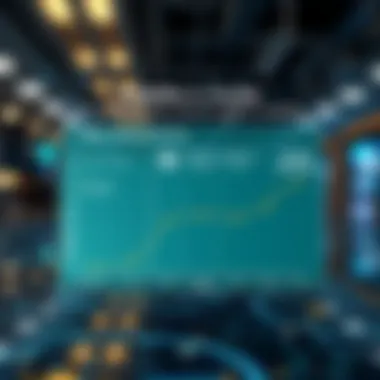Discovering Top NFT Networks: Features & Insights


Intro
As the digital landscape evolves, so too does the fascinating world of Non-Fungible Tokens (NFTs). These digital assets have transformed how we perceive ownership and authenticity in a plethora of fields, spanning from art to music and gaming. However, within the realm of NFTs, the networks themselves play a paramount role in determining the accessibility and efficiency of these unique tokens.
Understanding the various NFT networks is not just an academic exercise for traders and tech enthusiasts; it is a critical step to achieving success in the ever-changing marketplace. Each network unterschiedlich has its own set of characteristics, advantages, and limitations, influencing the performance and viability of NFTs.
The upcoming sections will provide a thorough examination of trends in cryptocurrency, investments strategies tailored towards NFTs, and detailed insights about the scalability and security aspects of different networks. Through this guide, readers will gain crucial knowledge enabling them to choose the ideal NFT network that aligns with their objectives. Let's dive into the currents that shape the NFT space.
Prelude to NFT Networks
In recent years, the rise of digital ownership has ushered in an era where art, collectibles, and virtual assets coexist in the ever-expanding realm of blockchain technology. Non-fungible tokens, or NFTs, represent a fundamental shift in how we perceive value in the digital world. NFT networks serve as the backbone of this evolving landscape, facilitating the creation, transfer, and sale of unique digital items.
With an increasing number of artists, gamers, and investors gravitating towards NFTs, understanding the quintessential merits and functionalities of various NFT networks is paramount. Just like a sturdy foundation underpins a grand structure, the right network can significantly impact the user experience and overall satisfaction of NFT transactions.
Defining Non-Fungible Tokens
At their core, non-fungible tokens are unique digital identifiers that denote ownership of a specific asset—be it digital art, music, or virtual real estate. Unlike traditional cryptocurrencies such as Bitcoin or Ethereum, which are fungible and can be exchanged on a one-to-one basis, NFTs stand alone with distinct attributes that make them irreplaceable. This uniqueness is akin to a fingerprint: you’re not going to mistake one for another. For instance, a piece of digital artwork minted as an NFT carries its own metadata, ensuring its owner possesses an original rather than a mere copy.
In practical terms, NFTs leverage smart contracts—self-executing contracts coded to automate agreements—which validate ownership and track provenance on the blockchain. This brings an unprecedented level of transparency to digital ownership, which is crucial in an age where piracy and content theft are rampant.
Importance of NFT Networks
The significance of NFT networks extends beyond mere transactions; they represent an entire ecosystem promoting creativity, commerce, and community.
- Facilitating Trust: These networks create an environment where trust is inherent, allowing artists and collectors to engage without fear of fraud.
- Breaking Barriers: Many artists previously lacked the means to reach global audiences, but NFT networks democratize access to buyers around the world, allowing individuals to monetize their creations more effectively.
- Community Engagement: Many networks are built around strong communities that motivate collaboration and innovation. These communities often provide resources for new creators and encourage peer-to-peer support.
- Economic Growth: As these networks gain traction, they contribute to a burgeoning digital economy, opening opportunities not just for artists but also for developers, marketers, and entrepreneurs.
In summary, as the fascination with digital assets deepens, grasping the nuances of NFT networks becomes not only beneficial but essential for traders, investors, tech enthusiasts, and creators alike. Their ability to transform digital ownership is not a fleeting trend, but a lasting revolution in how we create, share, and value arts and collectibles.
"Understanding NFT networks is akin to deciphering a new language of ownership, one that reimagines the way we connect with art and digital assets."
With this foundation set, let’s delve deeper into the criteria that will help us evaluate the many NFT networks, ensuring informed decisions in our digital ventures.
Criteria for Evaluating NFT Networks
When embarking on the journey of exploring NFT networks, it's essential to have a solid foundation on what to look for. As the landscape of non-fungible tokens evolves, distinguishing the standout networks from the rest becomes crucial. Below are the key criteria that every investor, developer, or enthusiast should consider while navigating this complex realm.
Scalability Considerations
Scalability is a vital aspect of any blockchain, especially for NFT networks that might need to handle millions of transactions, particularly during peak hours. This concept refers to a network's ability to accommodate a growing number of transactions without facing bottlenecks. Think of it as the capacity of a restaurant; during lunchtime rush, can it serve customers quickly, or do they end up waiting forever?
For instance, Ethereum has been under scrutiny for its transaction times and costs, particularly during heavy traffic events like major NFT drop dates. Solutions such as Layer 2 scaling solutions like Optimism or Arbitrum are gaining traction as workarounds to Ethereum's limitations. These alternatives aim to enhance transaction speeds and reduce fees.
In contrast, newer networks like Solana flaunt their swift transaction speeds and high throughput, making them very appealing for NFT creators and collectors alike. In essence, understanding the scalability options of a network can determine not just user experience but could also affect the long-term viability of a project.
Security Protocols
Security cannot be overstated in the NFT landscape. With increasing amounts of capital flowing into these digital assets, the need for robust security protocols becomes paramount. Investors expect their assets to be safe from hacks or breaches, which by the way, are all too common these days.
NFT networks often employ various consensus mechanisms—like Proof of Stake or Proof of Work—to secure their transactions. Each has its strengths and weaknesses. For example, Bitcoin utilizes Proof of Work, which, while very secure, can be resource-intensive. On the flip side, platforms utilizing Proof of Stake, like Tezos, typically consume less energy but can face different challenges regarding centralization.
Attention should also be given to whether the network has undergone any security audits from reputable sources. A diligent developer community often keeps up with cross-checking and reinforcing the network's security measures. As always, do your homework; a network with a history of breaches should set off alarm bells for potential investors.
User Experience and Accessibility
User experience (UX) is what keeps users coming back for more or deters them altogether. A smooth, intuitive interface can make or break an NFT project. Users want to easily create, buy, sell, and interact with NFTs without getting entangled in the complexities behind the scenes.
Additionally, accessibility means how easy it is for users of all backgrounds to navigate the network. For example, platforms that require extensive crypto knowledge or complex wallets may exclude potential creators or collectors. This is where networks like Flow shine; designed with the end-user in mind, they simplify the NFT tokenization process to appeal to a broader audience.
To further enhance accessibility, some networks are beginning to integrate fiat payment options, allowing those new to the crypto scene to participate without needing to first acquire cryptocurrency. Ensuring that the platform has mobile applications adds another layer of convenience that users now expect in today’s fast-paced environment.
Ecosystem Support and Developer Community
The ecosystem surrounding an NFT network can massively influence its success and longevity. A vibrant developer community means ongoing projects, innovations, and support, while a sparse ecosystem often leads to stagnation. Many forget that the developers are the beating heart of these networks.
Successful NFT networks usually boast an array of tools, services, and support from knowledgeable developers. Look for platforms that encourage developer engagement through resources, forums, and hackathons. Incentives such as grants or rewards can foster innovation.


Moreover, a healthy marketplace filled with artists, collectors, and projects can drive user interest and participation. This ecosystem is akin to a bustling farmers market; the more variety and appeal, the more people will linger. Engaging communities, be they on platforms like Discord or Reddit, can provide insights and tips, making the journey through NFTs smoother and more informed.
In summary, evaluating NFT networks extends beyond mere technical specifications. Scalability, security, user experience, and ecosystem support serve as pillars upon which the success of NFT networks is built. Ultimately, a careful consideration of these criteria can lead to better decisions and more rewarding experiences in the NFT landscape.
Ethereum: The Pioneering NFT Network
Ethereum has etched its name as the bedrock of the NFT universe, setting the stage for countless digital assets. This section dissects what makes Ethereum a vital player in this burgeoning arena, unpacking its technology, widespread adoption, and the hurdles that lie ahead.
Overview of Ethereum's Architecture
At the core of Ethereum's capabilities lies its blockchain architecture, which distinguishes it from many traditional systems. Unlike centralized databases, Ethereum operates on a decentralized network of nodes that facilitates the creation and execution of smart contracts. This unique feature allows developers to build applications that are both transparent and immutable.
Just to break it down a bit:
- Smart Contracts: These are self-executing contracts with the terms written directly into code. They automatically enforce and execute necessary actions when predetermined conditions are met.
- Ether (ETH): This is the fuel that powers the network. Users need Ether to interact with smart contracts and conduct transactions.
Furthermore, Ethereum employs a proof-of-work consensus algorithm, but is transitioning to proof-of-stake, a shift that not only elevates efficiency but also aims to lessen its environmental footprint.
Market Dominance and Adoption
Ethereum's market presence is monumental. As of the latest reports, over 80% of NFT transactions occur on its platform. Art pieces, music albums, virtual real estate—name it, and chances are it’s minted on Ethereum. This flourishing ecosystem has attracted not only artists and collectors, but also established brands looking to tap into digital innovation, highlighting its massive adoption.
- High-Profile Projects: Platforms like OpenSea and Rarible have built their foundations on Ethereum, allowing users to buy, sell, and trade various digital assets effortlessly.
- Community Engagement: A thriving community of developers and creators constantly pushes for innovation, ensuring that Ethereum remains at the forefront of the NFT revolution.
With this widespread acceptance, Ethereum isn't merely a player in the NFT space; it’s the benchmark against which other networks are compared.
Challenges and Limitations
Even giants have their Achilles' heels. Ethereum faces significant challenges, particularly concerning scalability and fees. The surging transaction volume has often led to network congestion, meaning high gas fees and slow transaction times during peak periods. This can deter newcomers and smaller investors, raising concerns about accessibility.
Additionally:
- Environmental Concerns: The energy consumption associated with Ethereum's current proof-of-work model has sparked critiques from environmentalists, though the transition to proof-of-stake is anticipated to mitigate these issues.
- Competition: Emerging networks such as Binance Smart Chain and Solana are carving out niches by offering lower fees and faster transaction times, potentially attracting users away from Ethereum's urban sprawl.
"The saga of Ethereum is not just about triumphs, but also the lessons embedded in its limitations."
For more detailed information, you can check out Ethereum on Wikipedia and join discussions about its future direction on Reddit.
Alternatives to Ethereum
In the realm of non-fungible tokens, Ethereum shines as a trailblazer, yet it's becoming increasingly apparent that other networks offer compelling alternatives. The significance of exploring these alternatives is multi-fold. While Ethereum remains a powerhouse, issues related to gas fees and transaction speed often discourage users. For creators and investors alike, an array of options is key to finding a network that not only meets financial parameters but also aligns with specific goals for digital asset utilization.
Flow: The Network for Digital Collectibles
Flow stands out as one of the most innovative platforms specifically designed for digital collectibles. The architecture of Flow allows it to handle millions of users without compromising speed or efficiency. In a nutshell, it’s like having your cake and eating it too—robust functionality combined with user-friendly access.
Flow’s unique design separates consensus mechanisms from execution, paving the way for greater scalability. This means collectors can trade digital art and other NFTs without the nagging worry of long wait times. Think of it as a dedicated lane on the highway for NFT transactions. Popular brands such as NBA Top Shot have successfully harnessed Flow, validating its worth in the competitive NFT space.
Binance Smart Chain: Opportunities and Risks
Next up is the Binance Smart Chain, a network that has created a buzz with its dual features of fast transaction speeds and lower fees. This makes it an attractive option for traders who want to dip their toes into NFTs without a hefty financial commitment. However, be cautious; it’s essential to weigh opportunities against risks.
Binance Smart Chain allows users to experience the NFT market at a fraction of the costs compared to Ethereum. Still, it's crucial to note that this ecosystem faces its challenges, including less decentralization and frequent security concerns. Projects like BakerySwap have gained traction, but they come with their share of scrutiny. Doing due diligence is vital before diving into this bustling market.
Tezos: Sustainability in NFT Creation
Tezos enters the conversation with a strong emphasis on sustainability. In an age where climate change is a growing concern, especially in the crypto world, Tezos champions eco-friendly practices. Its proof-of-stake model leads to significantly lower energy consumption compared to traditional proof-of-work systems. This makes it a top choice for artists and collectors passionate about the planet.
Artists often find Tezos appealing because it allows for quick minting of NFTs with minimal fees, promoting higher accessibility. Art projects such as Hic et Nunc showcase the unique capabilities of Tezos, allowing users to interact with NFTs while remaining environmentally responsible. This balance of quality and eco-consciousness has positioned Tezos as a frontrunner in the sustainable NFT movement.
Polygon: Enhancing Ethereum's Capabilities
Polygon is not just another network; it's a game-changer that acts as a layer-2 solution for Ethereum. By addressing some pressing issues that plague Ethereum, Polygon marries the best of both worlds. It enhances Ethereum’s capabilities and allows a smoother user experience, akin to putting a new set of tires on a trusty but worn-out vehicle.
With faster transactions and lower fees, Polygon is a haven for traders tired of soaring gas costs on Ethereum. Prominent projects like Aavegotchi and Decentraland are integrated on this network, proving that it hosts a diverse range of activities. By optimally utilizing its infrastructure, Polygon champions decentralized applications while ensuring speed and affordability, which is crucial for everyday users.
In summary, the exploration of these alternatives—Flow, Binance Smart Chain, Tezos, and Polygon—reveals that each has unique benefits. Ultimately, the choice depends on individual needs, investment goals, and commitment to sustainability. Each network offers valuable features that could be better suited to specific projects or personal preferences. Understanding these options is key to navigating the NFT landscape successfully.


Emerging NFT Networks
The evolving landscape of NFT networks is not just about established giants. Emerging NFT networks are shaking things up, introducing innovative features and addressing the limitations of older platforms. As the NFT market expands, these fresh contenders offer specific benefits that appeal to artists, collectors, and investors alike. Recognizing their potential is essential for anyone looking to remain ahead in the rapidly changing digital asset space.
Emerging networks often prioritize speed, cost-efficiency, and sustainability in their designs. For those who are pessimistic about certain long-standing platforms because of issues like high gas fees and slow throughput, these new options provide viable alternatives. Let’s explore a few of these networks and their unique qualities.
Cardano: A New Contender
Cardano has made a splash in the NFT world by prioritizing a strong proof-of-stake consensus mechanism. This makes transactions not only more energy-efficient but also scalable, drawing attention from both artists and investors. Developers are finding a home there thanks to the network’s emphasis on peer-reviewed research and academic rigor.
What sets Cardano apart is its layered architecture, which separates the settlement layer from the computation layer. This flexibility allows for complex programmable transactions while keeping costs down. As the ecosystem builds, the introduction of smart contracts on Cardano also opens doors for creative NFT use cases.
Solana: Speed and Scalability
When talking about speed, Solana often tops the discussion. With its ability to process thousands of transactions per second, it truly competes fiercely with traditional financial systems. Solana's unique proof-of-history mechanism significantly enhances scalability while keeping latency to a minimum. Artists and developers can leverage this network to launch projects with that quick turnaround, which is becoming increasingly important in a fast-paced market.
Additionally, Solana's low transaction fees stand in stark contrast to other platforms where fees can be a deal-breaker. This accessibility is appealing especially for smaller creators wanting to mint affordable NFTs and get them into the hands of collectors quickly.
Algorand: Focus on Performance
Algorand enters the scene with a laser focus on performance and decentralization. Utilizing a pure proof-of-stake consensus mechanism, the network achieves fast confirmation times and secure transactions. What’s particularly interesting is Algorand's commitment to solving the so-called "blockchain trilemma": achieving scalability, security, and decentralization simultaneously.
The network supports smart contracts and decentralizes applications, making it a versatile option for NFT projects. Whether it's art, music, or any innovative concepts, Algorand sets itself up as an excellent platform catering to various needs. Artists and creators can join a thriving, developer-friendly community that’s enthusiastic about fostering digital assets.
Hedera Hashgraph: The Future of NFTs
Hedera Hashgraph is carving its niche with promises of high throughput and low latency. Rather than a traditional blockchain, it operates on a unique structure called a hashgraph, which enhances performance without compromising security. This innovative approach makes Hedera a standout, drawing attention from companies who wish to harness NFTs for business applications.
Additionally, Hedera emphasizes governance and stability, with a council made up of global enterprises steering its evolution. This can offer reassurance to creators who may worry about the sustainability of newer networks. Hedera’s focus on corporate use creates intriguing possibilities for the merging of traditional media and digital art.
Emerging NFT networks continue to evolve, presenting exciting options alongside established players. As various industries adopt these technologies, the future of NFTs looks promising. Keeping an eye on developments in this sector is crucial for those who want to tap into the powerful potential of digital assets.
"Keep your eyes peeled. Emerging networks will often be the ones to offer solutions to today’s problems in NFT markets."
For further reading about NFT technology, you might explore resources such as Wikipedia and Investopedia.
The horizon of NFT networks is growing, and the early movers will certainly benefit from both opportunities and challenges as the stakes continue to rise.
Comparative Analysis of Top NFT Networks
Understanding the landscape of NFT networks is essential for anyone looking to engage with digital assets. This section digs into the comparative elements of various networks, offering insight into their transaction capabilities, their environmental impact, and the costs involved. By analyzing these aspects, traders, investors, and tech enthusiasts can make more informed decisions when selecting an NFT network that aligns with their objectives. The nuances can often dictate not just what assets can be created or traded, but also how sustainable and cost-effective those transactions are.
Transaction Speed and Efficiency
When it comes to transaction speed, the capabilities of an NFT network can make or break its usability. A slower network can create bottlenecks, especially when demand is high. For example, Ethereum, while being the most prominent NFT platform, has historically struggled with congestion. This has led to some transactions taking hours, or even days, to confirm. Compare this to Solana, which boasts lightning-fast transaction speeds—often under five seconds per transaction—this aspect is critical for those looking to invest in limited-time assets or participate in fast-paced virtual events.
Here's a quick breakdown of transaction speeds across popular networks:
- Ethereum: 30 transactions per second (TPS) but often congested.
- Solana: 65,000 TPS with low latency.
- Polygon: 7,000 TPS on average, integrating seamlessly with Ethereum.
The efficiency of these networks not only enhances the user experience but also impacts how liquidity can be managed within the NFT market.
Environmental Impact and Sustainability Measures
The environmental concerns surrounding NFTs have garnered attention, especially as news of high energy consumption spreads. Ethereum's proof-of-work mechanism requires massive computational power, raising questions about its sustainability. On the other hand, networks like Tezos and Flow utilize more environmentally friendly proof-of-stake or other innovative protocols that minimize energy use.
"The future of NFTs hinges not just on how transactions are conducted but also on how sustainably they can be managed."
Here are some key environmental considerations:
- Ethereum: High carbon footprint due to proof-of-work.
- Tezos: Eco-friendly, using a proof-of-stake consensus.
- Flow: Designed for efficiency with sustainability in mind.
These aspects can be paramount when buyers choose which networks to support, impacting their purchase decisions significantly.
Costs and Fees Associated
Financial considerations are also something to keep in mind when browsing NFT networks. Each network has its own fee structure for transactions, and these costs can vary wildly. On Ethereum, gas fees can soar to exorbitant levels during peak times, which makes trading or creating NFTs feel like a gamble. Conversely, networks such as Binance Smart Chain offer lower transaction fees, which can be appealing to newer investors or smaller trades.


Here's an overview of fee structures across major NFT networks:
- Ethereum: Gas fees can range from $10 to over $100, depending on network congestion.
- Binance Smart Chain: Average transaction fee typically under $1.
- Cardano: Maintains low fees, often less than $0.15 per transaction.
This financial aspect cannot be ignored, especially for those who seek to maximize returns on their investments in NFTs. Knowing where the best value lies can directly influence how users engage with different networks.
In summary, a comparative analysis of NFT networks shines light on their unique advantages and drawbacks. Speed, sustainability, and costs are critical components shaping the buyer’s journey, making understanding these differences vital for anyone involved in the NFT space.
Case Studies of Successful NFTs
The world of NFTs is replete with stories of triumph and innovation. By examining successful cases of NFTs, we gain insights not only into what makes a specific network or creation stand out but also into the broader implications for future developments in digital assets.
These case studies exemplify how unique features and strategic decisions can lead to remarkable outcomes, offering lessons to traders, investors, and tech enthusiasts alike.
Art and Collectibles
Art has always been a canvas for expression, but with NFTs, it has taken on an entirely new form. The sale of Beeple's "Everydays: The First 5000 Days" for a staggering $69 million at Christie's auction house showcased the power of NFTs in the digital art realm. This piece served not just as a digital artwork but as a cultural phenomenon, making headlines worldwide.
Key elements include:
- Provenance: Blockchain technology ensures the authenticity of each piece, allowing collectors to verify the history of ownership.
- Accessibility: Emerging artists can publish their work on platforms like OpenSea or Rarible, reaching buyers who may never have seen their creations otherwise.
- Community Engagement: Platforms like Foundation foster communities around specific artists or movements, enhancing the desirability and value of artworks.
Such examples illustrate how the intersection of technology and creativity is reshaping the art landscape, making NFTs a significant topic of discussion for collectors and investors.
Gaming and Virtual Worlds
With the dawn of blockchain technology, the gaming industry has experienced a shift towards more rewarding ecosystems for players. Titles like Axie Infinity have revolutionized play-to-earn models, allowing players to earn NFT assets that hold real-world value. Players breed, trade, and battle creatures called Axies, with some going for thousands of dollars.
Several factors highlight the significance of NFTs in gaming:
- Ownership: Players have true ownership of their in-game items as NFTs, contrasting sharply with traditional models where items are often leased rather than owned.
- Play-to-Earn Appeal: This game structure incentivizes participation, making gaming not just entertainment but a source of income for many.
- Interoperability: Assets from one game can sometimes be used in another, creating vast possibilities in virtual environments.
The success of gaming-related NFTs indicates a burgeoning market ripe for exploration, with numerous opportunities for those enthusiastic about both gaming and blockchain technology.
Music and Entertainment
The music industry, ever evolving, has begun tapping into the potential of NFTs as well. Artists like Grimes and Kings of Leon have minted their music as NFTs, which allows them to establish direct relationships with their fans while retaining more control over their work. Kings of Leon even offered special perks for NFT holders, including front-row seats to future concerts.
Key considerations include:
- Royalty Systems: NFTs can facilitate royalty payments directly through smart contracts, ensuring artists receive payment every time their music is resold.
- Exclusive Experiences: Music NFTs often come bundled with exclusive content—be it a backstage pass or limited edition tracks—making fans feel more connected to their favorite artists.
- New Revenue Streams: Traditional platforms often take a sizable cut of earnings. By leveraging NFTs, artists can significantly boost their earnings from sales.
These narratives show how NFTs are carving out new pathways in music and entertainment, influencing both industry dynamics and fan engagement.
"NFTs are not just a trend; they represent a transformation in how we think about ownership and value — especially in art, gaming, and music."
By studying these case examples, it’s evident that the potential of NFTs is multifaceted, presenting a wide array of opportunities for both creators and investors in the digital space.
Closure: Choosing the Right NFT Network
As we wrap up our exploration of NFT networks, it’s clear that making an informed choice in this fragmented marketplace is essential. The right network goes beyond just the shiny bells and whistles; it aligns seamlessly with your individual goals. For artists, developers, and investors alike, finding the perfect fit can mean the difference between success and stagnation.
Diversity among NFT networks means there's a variety of options, each catering to different needs. Some networks are lauded for their speed and low transaction fees, while others boast strong security protocols and a supportive community. A deeper dive into each network’s unique perks can uncover opportunities that might be beneficial for one’s particular objectives.
Aligning Network Choice with Goals
Choosing an NFT network should start with clarity on your personal or business goals. Ask yourself: Are you here to create collectible art? Engage in gaming? Perhaps you're more focused on investment returns? These questions shape your path.
- Art and Collectibles: If your aim is to showcase digital art, platforms like Ethereum may be your best bet due to their established ecosystem. However, emerging networks like Solana might offer faster transaction speeds and lower fees for artists.
- Gaming: For game developers, options like Flow can provide a more tailored experience designed specifically for the gaming community. The infrastructure can enhance player interaction and improve user retention.
- Investment: Investors should weigh potential for growth and sustainability. Networks with a robust community and ongoing developments, such as Tezos or Algorand, often indicate longevity and trustworthiness in the market.
This alignment ensures that your chosen NFT network not only meets immediate needs but positions you favorably for future endeavors in this dynamic space.
Looking Ahead: The Future of NFT Networks
As we cast our gaze toward the horizon, the future of NFT networks seems promising yet complex. With technological advancements in blockchain and growing interest from various industries, we can expect several trends to take shape:
- Increased Interoperability: Future NFT networks might prioritize cross-chain capabilities, allowing assets to move fluidly between different platforms, enhancing usability and liquidity.
- Sustainability Efforts: Rising concerns about the environmental impact of blockchain technology may drive innovations towards more eco-friendly networks. Expect an uptick in energy-efficient alternatives and carbon offset projects.
- Regulatory Developments: As governments begin to better understand and regulate digital assets, networks that comply with legal standards may gain more mainstream acceptance. This could result in a clearer path for mainstream adoption of NFTs.
- Expansion into New Territories: With sectors like music, fashion, and academia beginning to tap into NFTs, the networks serving those niches will likely see tailored developments to cater to new audiences.
"In the world of NFTs, wisdom lies in knowing which networks resonate best with your vision and allowing those to steer your journey through this expansive ecosystem."
For more information, check resources at
Wikipedia
Britannica
Reddit
Facebook
Government
Education
Maintaining a finger on the pulse of this rapidly evolving space is crucial for anyone invested in NFTs.







